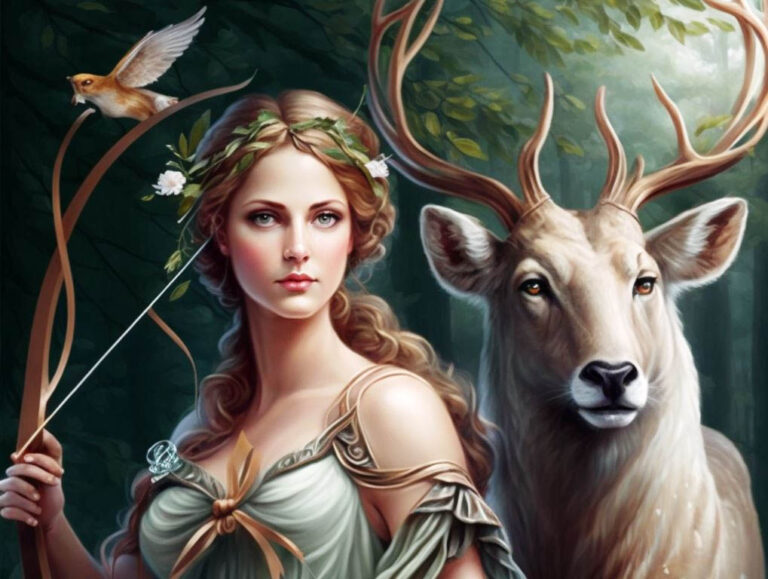Άρτεμη, one of the most honored of the ancient Greek deities, stands as a symbol of independence, electricity, and natural concord. Often depicted as a huntress carrying a bow and arrows, she is the daughter of Zeus and Leto and the twin sister of Apollo. This article explores the multifaceted components of Artemis, delving into her origins, attributes, mythology, worship practices, and her enduring have an effect on on way of life and the humanities.
Origins and Family
Artemis turned into born on the island of Delos to Zeus, the king of the gods, and Leto, a Titaness. According to fantasy, her birth was not with out problem. Hera, Zeus’s wife, became jealous of Leto and prohibited her from giving beginning on solid ground. Leto discovered safe haven on the floating island of Delos, in which she gave start to Άρτεμη and, quickly after, to Apollo. This brilliant beginning set the degree for Artemis’s divine role and her close bond along with her brother.
Attributes and Symbols
Άρτεμη is regularly depicted as a younger and vigorous huntress, clad in a brief tunic appropriate for her forest activities. She is usually accompanied by way of a stag or searching dogs and is ready with a bow and arrows, presents from the Cyclopes. The crescent moon is also associated with Artemis, reflecting her role as a lunar deity. Her symbols constitute her dominion over nature, animals, and the wasteland, emphasizing her position as a protector of younger girls and childbirth.
Mythological Tales
The mythology surrounding Άρτεμη is rich with memories that highlight her fierce independence and shielding nature. One famous story is that of Actaeon, a hunter who stumbled upon Artemis bathing. In her wrath, she converted him right into a stag, and he become torn aside by means of his very own hounds. Another first-rate fable is the story of Niobe, who boasted of being superior to Leto for having extra youngsters. In reaction, Artemis and Apollo killed Niobe’s youngsters, demonstrating the twins’ loyalty to their mother.
Worship and Rituals
Artemis was broadly worshipped throughout the Greek international, with numerous temples committed to her. The most famous of these was the Temple of Άρτεμη at Ephesus, one of the Seven Wonders of the Ancient World. Worship practices frequently protected offerings of food, drink, and small figurines. Festivals which includes the Brauronia, held in her honor, worried rituals wherein young women dressed as bears in a ceremony of passage. Artemis’s worship become deeply intertwined with nature, emphasizing purity and safety.
Άρτεμη in Roman Culture
The Romans identified Artemis with their personal goddess Diana. While Diana retained many traits of the Greek Artemis, she also absorbed elements of different deities, becoming a extra complex determine in Roman religion. The worship of Diana turned into good sized inside the Roman Empire, and she became regularly depicted in art and literature, reflecting the syncretism of Greek and Roman spiritual practices.
Άρτεμη in Modern Culture
Artemis’s legacy extends into cutting-edge instances, where she is seen as a image of lady empowerment and environmentalism. Her picture as an unbiased and strong huntress resonates with current values of girls’s independence and ecological focus. In literature, artwork, and even space exploration, Artemis continues to encourage. For example, NASA’s Άρτεμη program, geared toward returning people to the Moon, aptly reflects her affiliation with the lunar sphere.
Artistic Representations
Throughout records, Άρτεμη has been a popular difficulty in art, from historical sculptures and pottery to Renaissance paintings and modern illustrations. Each era has interpreted her image via its cultural lens, highlighting distinct components of her persona. The enduring enchantment of Artemis in art showcases her multifaceted nature and the undying fascination she holds as a divine determine of nature and the quest.
Conclusion
Άρτεμη, the Greek goddess of the search, embodies a completely unique mixture of strength, independence, and herbal concord. Her mythology, attributes, and enduring cultural impact reflect the values and beliefs of the historic Greeks even as continuing to inspire cutting-edge interpretations. As a protector of the wild and a image of woman empowerment,Άρτεμη stays a powerful and relevant determine in each historical and contemporary contexts. Through worship, myth, and art, the legacy of Artemis endures, highlighting the timeless nature of her divine attributes and the human fascination with the mysteries of nature and the divine.

1 Comment
Thanks for sharing. I read many of your blog posts, cool, your blog is very good.